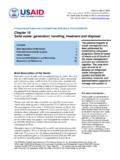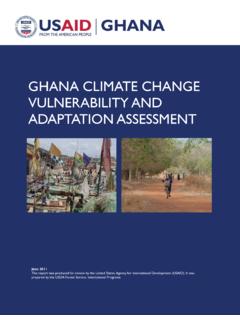Transcription of Chapter 4. Writing the Initial Environmental Examination …
1 Environmental PROCEDURES TRAINING MANUAL (AFR). Chapter 4. Writing the Initial Environmental Examination (IEE). As explained in the previous Chapter , your screening outcomes determine if you must undertake an IEE. This Chapter guides you through the process of Writing the IEE. Note that the process described here is representative of that Box applied in Environmental impact assessment processes anywhere in the IEE Basic Outline world. Suggested steps involved in preparing an IEE are: Program/Activity/Preparer Data:: Step 1: Decide the type of IEE you will write; 1 Background and Activity Description Step 2: assemble the relevant information resources; Purpose and Scope of IEE. Step 3: carry out the Environmental analysis ( , write sections 1 3.)
2 Of the IEE narrative); Background Description of Activities Step 4: consider recommended determinations (threshold decisions); 2 Country and Environmental Information (Baseline Step 5: settle on recommended threshold decisions and mitigation Information). and monitoring (write section 4 of the IEE narrative); Locations Affected National Environmental Step 6: fill in the Environmental Compliance Facesheet and attach Policies and Procedures to the IEE Narrative. (of host country, both with The Chapter begins with a brief review of the purpose and content of the respect to Environmental assessment generally, IEE, and then addresses each of these steps in turn. and any requirements NOTE: Steps 2 5 of the IEE are often an iterative process.
3 You prepare particular to the each section, following the outline to the extent that you have information. sector/activity.). You may need additional information and have to go back to various 3 Evaluation of Environmental sections and add detail or, in some cases, revise your conclusions. It is best Impact Potential to jump in and do what you can, then fill in and revise later. 4 Recommended Determinations and Mitigation Actions (Includes Monitoring and IEE Review Evaluation). The IEE is a review of the reasonably foreseeable effects on the environment Recommended Threshold of a proposed development intervention/activity. The purpose of the IEE is Determinations &. to provide information and analysis sufficient to reach one of four Conditions (includes conclusions (or threshold decisions) regarding the overall Environmental justification of categorical exclusions identified effects of the project.
4 For each activitiy addressed by the IEE, IEE preparers during screening). recommend one of these threshold decisions to USAID. USAID can accept or reject this determination. Mitigation, Monitoring and Evaluation 4-1 March 2005. Table : IEE outcomes IEE determination Explanation Implication (Reg. 216. terminology). Activity is likely to have Do full Environmental Positive significant adverse Assessment (EA), or determination Environmental impacts redesign project Activity has no significant Negative Project has passed adverse Environmental determination Environmental review impact With adequate mitigation By adding additional Negative and monitoring, activity mitigation to project design, determination with has no significant adverse project passes conditions Environmental impact Environmental review Project must be defined and IEE finalized and Not enough information to Deferral approved before any evaluate impacts irreversible commitment of resources can be made.
5 Note that the text of the IEE will also document any Categorical Exclusions identified during the screening process. Step 1: Decide the type of IEE you will write Regulation 216 does not specify the IEE format or outline. Over time, USAID practice has standardized around a set of basic approaches. All start from the same outline (Box , above). These basic approaches are described in Table Examine the first column of the table to see what situation best characterizes your proposal. Remember that the IEE must cover all the activities/components for which a screening outcome required an IEE. Note that subsequent guidance centers on Writing the IEE to the basic outline , to the basic or classic IEE described in the table.
6 IEE. examples in the Annex illustrate how this basic outline is adapted to various other IEE types. 4-2. Environmental PROCEDURES TRAINING MANUAL (AFR). Table : Guidelines for choosing the type of IEE you write Situation Type of IEE Comment and Explanation Well-defined, Basic or This is the most straightforward IEE. It requires specific information about closely related classic IEE the activities over their full lifecycle ( , over all phases of the activity), activities at one including site selection, design, construction, operation and site. decommissioning/abandonment. For example, a classic IEE describing agricultural interventions would detail these interventions, how they work, and where they will be implemented.
7 If, on the other hand, dams or river diversions are planned to irrigate an area, required information would include the design of the dam or diversion ( , height, volume of water impounded or diverted; location of the water source), upstream and downstream characteristics; etc. In both cases, information about the site, Environmental setting, farmers and their families would be required. Examples of classic IEEs and amendments are found in Annex D. Well-defined, Multi-site IEE Many USAID-supported programs carry out specific, well-defined activities closely related in numerous sites across a region or country. A multi-site IEE can be activities at prepared if the following conditions apply: multiple sites The multiple activities are well-defined, repetitive and/or predictable.
8 Impacts can be mitigated by measures readily identifiable in advance sites are known well enough to affirm that no unexpected impacts would occur in sensitive areas ( , wetlands, protected areas, etc.). In these cases, the multi-site IEE avoids the unnecessary effort of preparing an IEE for each site. Instead, the IEE analyses the activities in a general way, and identifies mitigation and monitoring measures sufficient to prevent significant adverse impacts. Common situations in which multi-site IEEs might apply include programs of latrine or well construction or terracing. At the beginning of the program or project, not every specific site may have been identified, but overall characteristics are known.
9 In these cases, the multi-site IEE would analyze all construction activities in the general Environmental context. The analysis would identify mitigation measures sufficient to prevent significant adverse Environmental effects. Mitigating measures might include training for local staff, and adoption of siting and construction guidelines to ensure the actions taken have no adverse Environmental implications ( , water sources will not be diverted, soil will not be eroded, and protected species will not be endangered, etc.). An example of a multi-site IEE is included in Annex D. Some activities IEE with deferral A deferral may be appropriate for an activity or major component when it is not yet fully not yet fully defined, sufficient information is unavailable, or a decision to defined pursue an activity is not yet definite.
10 This applies especially when you expect that at least some of the activities are not likely to be considered small-scale. The request for a deferral is made within the IEE (see (a)(7)).The IEE must be amended as soon as information about that activity becomes available. The deferred activity cannot proceed until the deferral in the IEE has been resolved. However, other activities addressed in the approved IEE and receiving negative determinations CAN proceed. An example of an IEE with deferral is included in Annex D. 4-3 March 2005. Situation Type of IEE Comment and Explanation Multiple sets of IEE with If the project or program includes several sets of dissimilar activities ( , dissimilar separate write- natural resources management, road construction, and water resources activities at one ups of sectoral works), it may be most efficient to address each sector in a separate or more sites.


